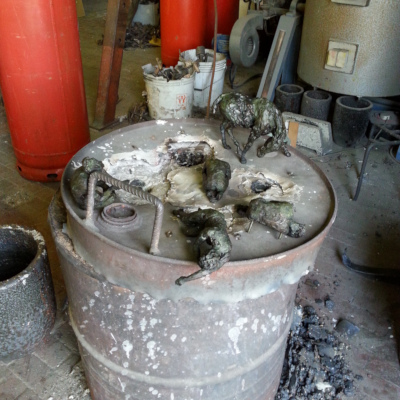Personally, I can't stand Renaissance-Brown!
If the 19th Century Greats were literally 'true to materials', our heritage of bronzes from that period would resemble the shiny gold appearance of C-3PO.
'Truth to materials' was a doctrine that stated sculpture should conform to the inherent qualities of the material it was being created from; its nature shouldn't be hidden or disguised. The Bauhaus movement taught 'Truth to Materials' as a central principal.
This principle put forward the thought, that whether a creation was made of stone, wood, steel or other substance, it did not hide the raw materials. Just the opposite: it celebrated them allowing the material to speak for itself: the material having its own form and structure. The term wasn't limited to sculpture, architecture also sang to this tune where, for example, it was considered appropriate to leave concrete unpainted.
Ironically supporters of the concept, artists like Henry Moore (1898-1986), produced sculpture that was not true to the material. His work 'Sheep Piece' had several different finishes, only one or two being true to natural bronze. Opponents to the concept, artists like Frederick Edward McWilliam (1909-1992), likewise send confusing signals. McWilliam produced art that was contradictory to his expression of anti-Truth to Material, such as his wooden Mulberry Figure series, that did conform to the idea. What this tells you is that the doctrine was not set in stone, if you will excuse the pun, and although the principle was loudly and widely taught, even its supporters did not follow it to the letter. Whilst it is a movement that's had a profound effect on people's mind set even today, it is, as most things in life, flexible.
'Truth to Materials' doesn't fit with bronze and in fact the likes of Henry Moore in my mind were slightly hypocritical in their advocacy toward it. His work may be brilliant but his notion of this ethos did not extend in practice to all of his bronze sculptures. Few of Moore's bronzes are true to the natural colour of newly produced bronze. Bronze in its raw state, fresh from the foundry mould, is a brilliant shiny gold colour. The same appearance as C-3PO, the humanoid robot in the 1970's original Star Wars movies.
Two of my sculptures pictured here, (Languid female and Temple Prop), demonstrate this. Both shown freshly cast at the foundry.

What artists are of course trying to emulate is the passage of time. Bronze age items (3000 to 1200BC) that have been buried for millennia are dug up having suffered the ravages of time; natural chemicals in the earth and atmosphere that corrode and change their appearance. For modern day artists, whilst the atmosphere will still play its part, the chemical alchemy of patination speeds up the process to resemble what most people think of as the look of 'bronze'. And whilst various colour forms have existed down the centuries, Renaissance-Brown seems to be the colour that most people accept as 'natural'. Can't stand it myself!
It's more difficult to swim against the tide but sometimes it's not a bad thing to do. Ask any migrating salmon that returns upstream to breed!
My way is not to deliberately swim against this tide of what is acceptable, but simply to be open to creativity. All of my sculptures have a touch of colour over and above a background of dark brown, sometimes almost totally covering the piece. In the sculptures pictured here a beautiful green dresses the pieces giving them a 'spirit of the woods' type of feel. The art of patination is fascinating and a part of the bronze making process that bonds the foundry to the finished sculptures that artists submit. One never quite knows how the colour will end up as it seems to change as it settles and cools. Wax is painted onto the hot metal post patination to be absorbed by the bronze and therefore protect it. This too has an effect on the colour. As does the extent of work on the surface: whether it is left matt or buffed to shine. Thankfully modern day art is much more liberal than the in early 1900's. A feast of exploration is just waiting to be expressed!
